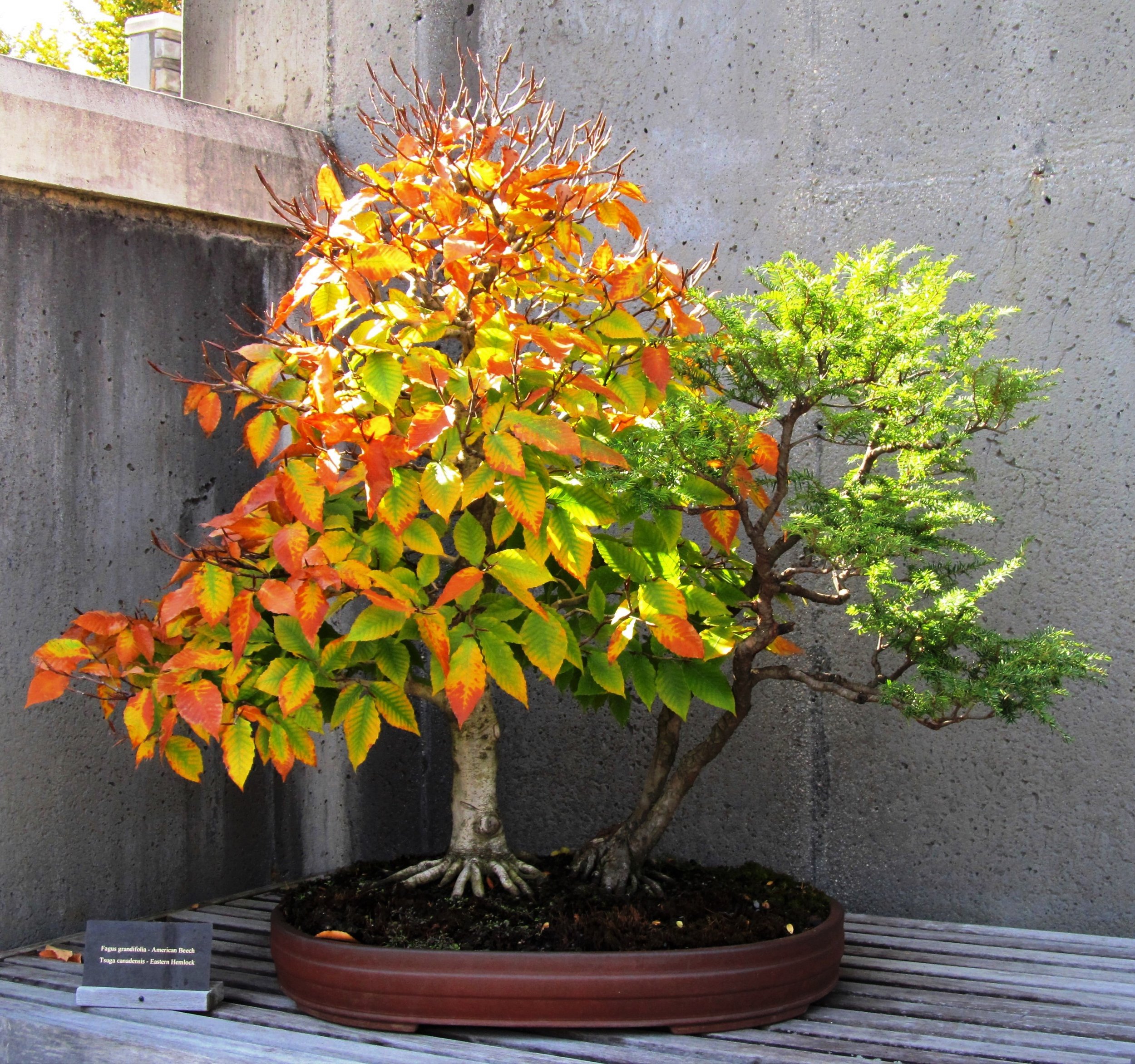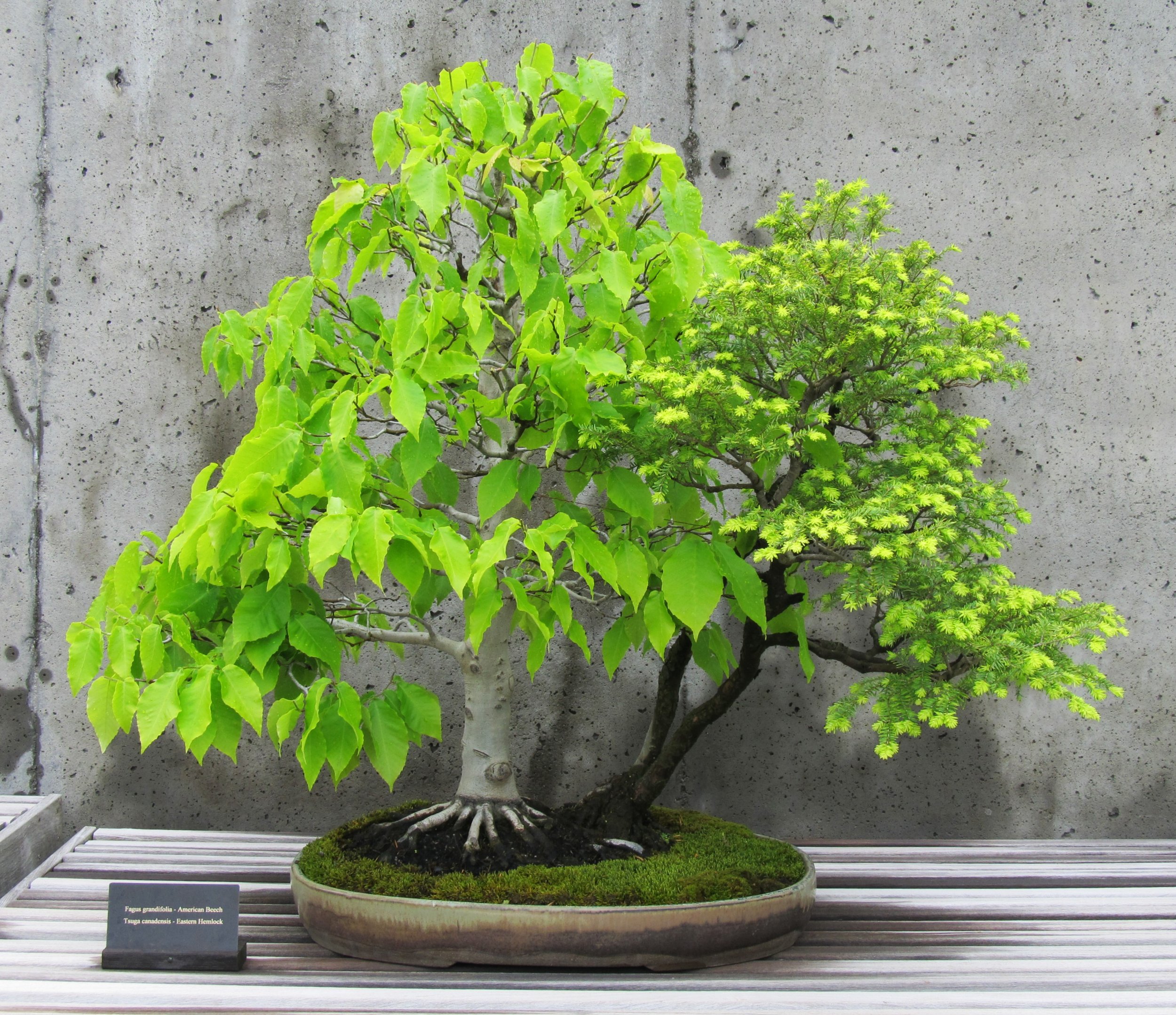Eastern Hemlock - Part 2
I felt good about the new bonsai that combined two native tree species. I had seen a mixed-species group planting at the National Bonsai and Penjing Museum as part of the Japanese bonsai collection, but in that case the trees used were Japanese white pine (Pinus parviflora) and Japanese beech (Fagus crenata). The memory of that planting was somewhere in my mind when I decided to try a combination of eastern hemlock (Tsuga canadensis) and American beech (Fagus grandifolia).
You won't see many American beech bonsai, and there is a reason for that. A clue can be found in the specific epithet in the botanical name for American beech: grandifolia, meaning large-leaved. Large leaves are not generally favored in bonsai. Large-leaved trees can sometimes be coaxed to produce smaller sized leaves after some years in bonsai training, and this was accomplished to some degree with the American beech I grew. I was able to reduce the leaves by about half, from the five or six inches they often are in nature down to about two to three inches, which is still pretty large for a bonsai. I wasn't thinking about that when starting out, however. I just wanted to try American beech because they are such an admirable species when seen in the landscape, and I hoped they would be equally appealing in bonsai form.
That desire reared its head one day long ago when I was at a park near where I lived and I had my son with me. He was no more than three years old at the time. There was an American beech full of beech nuts growing in the park, and there was a branch bearing the nuts low enough that I could just about reach it. I put my son on my shoulders and instructed him to reach up and grab some of the prickly things hanging down and pull them off. This he did. I planted the nuts and grew a bunch of beech trees from them, and introduced about fifteen of them to bonsai culture. The American beech I brought with me to Harrisburg for the demonstration was the best of the lot after about twelve years of cultivation. This personal backstory to the beech added even more meaning to the new bonsai that was created by combining that tree with the eastern hemlock from Mr. Yoshimura. The hemlock was a memory link to a teacher and a learning experience that changed my life, and the beech was a memory link to my days of being a young father to a couple of little boys. Time passes. That son who picked the beech nuts for me is now a middle-aged man, and if I were to try to put him on my shoulders he would telescope my spine.
It didn't take long for the beech-hemlock planting to get comfortable. Here it is out on display in the bonsai garden in 2011:
This photograph from early in 2013 shows the bonsai after its spring replanting. Note that for some reason the planting was put into a different container:
In the four years since the demonstration that brought them together, the beech and hemlock did well and both attained an agreeable degree of ramification in their branching. It is worth pointing out that even if a person is persnickety about larger sized leaves on deciduous bonsai trees, half the year there is no problem at all. American beech has distinctive leaf buds, too, so the winter look of this planting was particularly pleasing to me.
Speaking of winter appearance, the beech-hemlock bonsai happened to be out on display in late fall of 2013 when we received a light dusting of early snow:
The next image comes from 2014 and shows the beech in autumn color:
The beech-hemlock arrangement became a regular presence in the bonsai garden every year for seven years straight. Somewhere along the way the specimen wound up back in the same container it had been in previously, so whatever faults that pot might have had were apparently forgiven. The gallery below shows the planting in 2017, starting in early spring as new leaves were emerging on the beech, and continuing through the next four weeks as the hemlock pushed new growth and then both trees were fully flushed-out for the new growing season (click on any image for larger view):
There are no images of the beech-hemlock bonsai beyond early summer of 2017. The planting enjoyed normal, healthy growth all that year without incident, but the following spring the beech did not leaf out. The failure to produce new leaves at the normal time, when all the other deciduous plants are pushing new growth, is never a good sign. As the grower, your first response is to scratch on the bark of a branch on such a tree, looking for green tissue below the surface. If you see the color green there you wait awhile. Sometimes root damage might occur during a really cold winter spell and the tree might be slow to come out in spring, but it is still alive. You wait and maybe a couple of weeks later, or a month later, or sometimes even longer than that, the leaves finally show up. I think it might be that the tree puts energy into replacing lost roots first, then pushes new foliage when the damage to the system that supports the foliage has been addressed. That's just a surmise on my part, without any scientific evidence to back it up. I've had ample occasion to observe the phenomenon, though, because cold winters can damage roots and we sometimes have cold winters. It's a happy relief when a late-to-flush tree finally shows signs of life in the form of green leaves emerging, but it’s a sad loss when that fails to happen.
I cannot remember how long the beech sat there naked and non-growing but still showing green tissue below the bark. Meanwhile, the eastern hemlock came out of winter dormancy at the usual time in fine shape, and set about growing new foliage without hesitation. The vibrancy of the fresh new hemlock needles made the bare beech look more barren with each passing week.
Months went by. Finally there was no more green to be seen under the beech bark when scratching on a limb, so I did the same test on the trunk and found the same result. The American beech was permanently dormant. I let the beech-hemlock bonsai sit there on the bench in the hoop house just as it was that whole year, as if I thought some miracle would happen and the beech would come back to life. Few people saw it then, off display and hidden among the many plants kept in the growing area. But I saw that unhappy sight every day when I did the watering, because of course I still had to water the hemlock. The living tree was coupled to the dead tree, like Isis and Osiris in Egyptian mythology. I thought about showing the bonsai that way, the living and the dead, but then thought better of it. I should have taken a picture, but I could never bring myself to do it.
There are many ways a bonsai might die and sooner or later they all do. People often ask me if I think of the bonsai I grow as being like my children, but I never agree with that take because it overstates the case. You do become attached to your bonsai, though, especially if it's a specimen you have grown for a long time. It hurts when you lose them. As with any loss there is a process of coming to terms with the cold reality of it, then accepting it, and finally moving on to whatever comes next. The beech was done but Mr. Yoshimura's hemlock was still in the game. It was time to move on.
To be continued...








